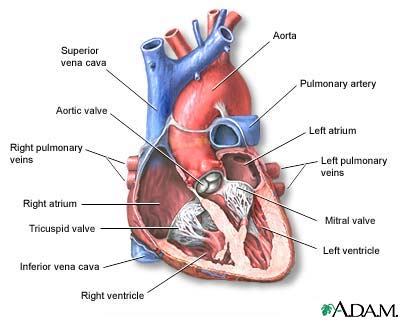Alternate Names : Coronary artery disease, Arteriosclerotic heart disease, CHD, CA
Definition
Coronary heart disease (CHD) is a narrowing of the small blood vessels that supply blood and oxygen to the heart. CHD is also called coronary artery disease.
See also:
- Angina
- Heart attack
- Unstable angina
Overview, Causes, & Risk Factors
Coronary heart disease is usually caused by a condition called atherosclerosis, which occurs when fatty material and a substance called plaque build up on the walls of your arteries. This causes them to get narrow. As the coronary arteries narrow, blood flow to the heart can slow down or stop. This can cause chest pain (stable angina), shortness of breath, heart attack, and other symptoms.
Coronary heart disease (CHD) is the leading cause of death in the United States for men and women.
Many things increase your risk for heart disease:
- Men in their 40s have a higher risk of CHD than women. But as women get older (especially after they reach menopause), their risk increases to almost equal that of a man’s risk. See: Heart disease and women
- Bad genes (heredity) can increase your risk. You are more likely to develop the condition if someone in your family has had a history of heart disease — especially if they had it before age 50. Your risk for CHD goes up the older you get.
- Diabetes is a strong risk factor for heart disease.
- High blood pressure increases your risk of coronary artery disease and heart failure.
- Abnormal cholesterol levels: your LDL (“bad”) cholesterol should be as low as possible, and your HDL (“good”) cholesterol should be as high as possible.
- Metabolic syndrome refers to high triglyceride levels, high blood pressure, excess body fat around the waist, and increased insulin levels. People with this group of problems have an increased chance of getting heart disease.
- Smokers have a much higher risk of heart disease than nonsmokers.
- Chronic kidney disease can increase your risk.
- Already having atherosclerosis or hardening of the arteries in another part of your body (examples are stroke and abdominal aortic aneurysm) increases your risk of having coronary heart disease.
- Other risk factors including alcohol abuse, not getting enough exercise, and excessive amounts of stress.
Higher-than-normal levels of inflammation-related substances, such as C-reactive protein and fibrinogen are being studied as possible indicators of an increased risk for heart disease.
Increased levels of a chemical called homocysteine, an amino acid, are also linked to an increased risk of a heart attack.
Pictures & Images
Heart, section through the middle
 The interior of the heart is composed of valves, chambers, and associated vessels.
The interior of the heart is composed of valves, chambers, and associated vessels.
Heart, front view

The external structures of the heart include the ventricles, atria, arteries and veins. Arteries carry blood away from the heart while veins carry blood into the heart. The vessels colored blue indicate the transport of blood with relatively low content of oxygen and high content of carbon dioxide. The vessels colored red indicate the transport of blood with relatively high content of oxygen and low content of carbon dioxide.
Acute MI

A heart attack or acute myocardial infarction (MI) occurs when one of the arteries that supplies the heart muscle becomes blocked. Blockage may be caused by spasm of the artery or by atherosclerosis with acute clot formation. The blockage results in damaged tissue and a permanent loss of contraction of this portion of the heart muscle.
Posterior heart arteries

The coronary arteries supply blood to the heart muscle. The right coronary artery supplies both the left and the right heart; the left coronary artery supplies the left heart.
Cholesterol producers

Cholesterol is a waxy, fat-like material that is found in all parts of the body. It comes from two sources: our liver produces it, and we consume it in meat and dairy products.
Anterior heart arteries

The coronary arteries supply blood to the heart muscle. The right coronary artery supplies both the left and the right heart; the left coronary artery supplies the left heart.
-
Coronary heart disease : Overview, Causes, & Risk Factors
-
Coronary heart disease : Symptoms & Signs, Diagnosis & Tests
-
Coronary heart disease : Treatment



Review Date : 4/23/2009
Reviewed By : Steven Kang, MD, Division of Cardiac Pacing and Electrophysiology, East Bay Arrhythmia, Cardiovascular Consultants Medical Group, Oakland, CA. Review provided by VeriMed Healthcare Network. Also reviewed by David Zieve, MD, MHA, Medical Director, A.D.A.M., Inc.
for all medical emergencies. Links to other sites are provided for information only — they do not constitute endorsements of those other sites. © 1997- 2010 A.D.A.M., Inc. Any duplication or distribution of the information contained
herein is strictly prohibited.
